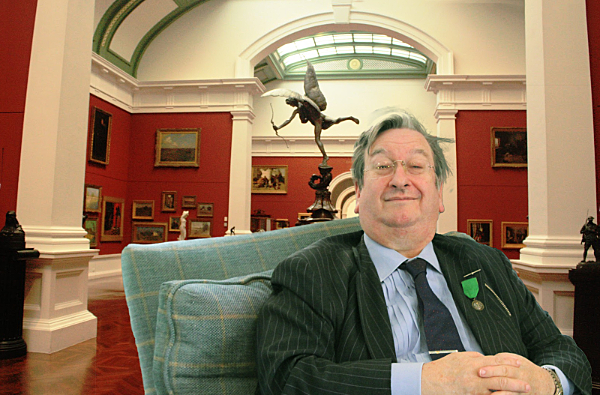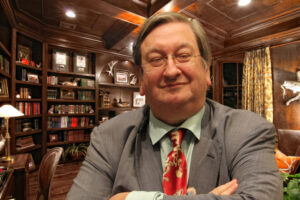
Survival of the Fattest: Raymond Keene OBE
- Posted by Marek Kasperski
- Categories Articles from Raymond Keene O.B.E.
- Date August 24, 2023
- Comments 1 comment
When it comes to theories of evolution, there are broadly three sensible options: if you are British, especially if you are a National Treasure, such as Sir David Attenborough, then Charles Darwin is your natural selection as the explanation for the evolutionary process. If, however, you are French, then it boils down to two choices, Lamarckian gradualism, or Cuverian catastrophism.
In the first half of the 19th century, the French naturalist Baron Georges Cuvier (1769-1832) developed his theory of catastrophes. In fact, in keeping with the spirit of his times, this Master of Disaster preferred the term revolution to catastrophe. Cuvier was immensely fat and thereby earned his nickname ‘The Mammoth’, coincidentally a pachydermic palaeolontogical research sphere in which he excelled. Britain’s greatest chess player, Nigel Short, once reduced me to helpless laughter by describing a certain, strikingly rotund, Soviet chess grandmaster as “spherical.” By all accounts, Baron Cuvier was certainly in that league.
According to Cuvier, the fossil record demonstrates that species, both plant and animal, are destroyed time and time again by volcanic eruptions, meteoric bombardments, giant deluges and countless other shocks and natural cataclysms, that living matter is heir to. In Cuvier’s interpretation of the life cycle of the planet, new species evolve only after each catastrophe or revolution has been completed. Obvious examples are the Permian and Cretaceous mass extinctions, also the igneous convulsions of the Deccan Traps from the early Palaeogene geological period.
A trenchant critic of Cuvier’s theory of cataclysms was his one time mentor, fellow French academic, Jean-Baptiste Lamarck (1744 -1829) who promulgated the view that all living things had originated from simple organisms, and were thus inextricably related to each other. So far, so good.
The varying species were, according to Lamarck, simply the outcome of disparate environmental conditions: in Lamarck’s world view, intensive use of certain body parts would result in their reinforcement and ipso facto ‘singular’ growth; their neglect, on the contrary, would lead to a reversal of their development, and eventual disappearance. The properties thus acquired, in the growth scenario, would be passed on to offspring.
Lamarck illustrated his theory by using the example of the evolution of giraffes. Giraffes must clearly have once had short-necked ancestors whose goal was to reach for the juiciest and highest leaves of certain trees. By constantly stretching their necks, those necks grew longer and longer, a property which they passed on to their offspring. The extended neck of the giraffe is said by Lamarck to have come into existence in this manner over many generations.
Unfortunately, Lamarck’s explanation sounds too close to the controversial theory of the inheritance of acquired characteristics. The dramatic story about the viability of this explanation of evolution, with its various pros and cons, is related in Arthur Koestler’s book The Case of the Midwife Toad (1971). Austrian scientist Paul Kammerer (1880-1926) sought to justify the theory that organisms may pass to their offspring characteristics acquired in their lifetime. Tragically, Kammerer committed suicide when his experiments were found to have been fraudulent, with Indian ink injected into certain parts of the anatomy of the amphibian in question, which, to add insult to injury, actually turned out to be a frog and not a toad at all.
If one is not convinced by Cuvier or Lamarck, that leaves only one winner, namely the British scientist who championed the survival of the fittest by the process of natural selection.
Charles Darwin (1809-1882) was convinced that features, such as the long neck of Artiodactyl ruminants, are the result of natural selection, according to conditions of existence. Accordingly, certain giraffes would have had longer necks through pure chance, and thereby enjoyed an aleatory advantage over other members of their species, in being able to reach sources of food that had hitherto been inaccessible to them. The animals passed on this accidental by- product of nature to their offspring, who, for their part, were better able to survive periods of food scarcity. Over geological time, therefore, the longer necked giraffes both survived and flourished. The short necks, unable to compete, died out.
Charles was influenced by his versatile grandfather Erasmus Darwin (1731-1802) a proto-evolutionist, physician, poet and slave trade abolitionist, whose surviving portraits indicate, like Cuvier, a man who, if not exactly spherical, was certainly of impressive girth.
Chess, too, has developed its own theory of evolution, principally through the work of chess champion/philosopher Emanuel Lasker. Lasker was an intellectual titan, long reigning World Chess Champion and friend of Albert Einstein (who wrote the foreword to Dr J. Hannak’s biography of Lasker). Lasker developed his own concept of evolution, which he construed as strictly teleological. His independence of thought was admirable and even led him to challenge Einstein about the theory of relativity, much as Goethe had challenged Newton over light and colour in his ZurFarbenlehre.
Lasker (1868-1941) was one of the most dominant champions, and he is still generally regarded as being amongst the strongest players ever to grace a chessboard. In 1906 he published a booklet titled Kampf (Struggle), in which he attempted to create a general theory, relevant to all competitive activities, including chess, business and warfare. Lasker’s philosophy can be summed up in this quotation from his writings: “By some ardent enthusiasts chess has been elevated into a science or an art. It is neither; but its principal characteristic seems to be – what human nature mostly delights in – a fight.”
Lasker advanced his idea of evolution based on struggle, by postulating the possibility of the ‘macheide’, meaning “son of battle,” a being whose attributes are so sharpened by evolutionary struggle, that it always chooses the best and most efficient method of perpetuating its own success.
On the chessboard, for example, the macheide would always make the best move, which would result (as one chess master remarked) in the sad result that after the first game between two macheides, chess would cease to exist.
Fortunately, the Macheide does not yet exist in its perfected form , which gave me the chance to win the British chess championship , the EU Gold Medal and become a Chess Grandmaster, before the curtain came down and it became too late!
Tag:Chess
You may also like


1 Comments
Great article, Ray; I always feel that after reading your blogs, I learn something new.